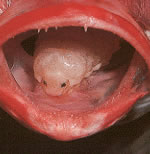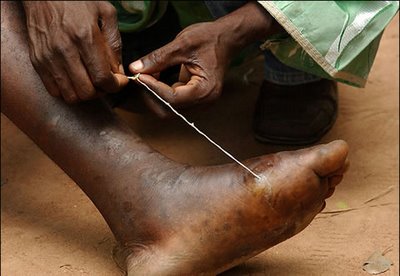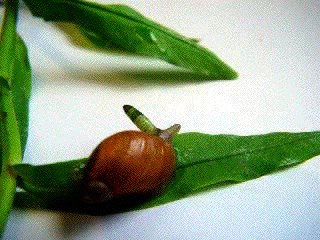Six Horrifying Parasites
When it comes to parasites, it’s all about perspective. You may call a lifetime of growing and feeding off another organism lazy, but we call it opportunistic. In fact, these life-sucking go-getters have managed to carve out some of the most ingenious survival strategies in the world. By some estimates, parasites outnumber free-living species nearly four to one. So show some respect. After all, mooching isnt’ as easy as it looks.

Cymothoa exigua: Biting Your Tongue, So You Don’t Have To.
When fish mommies want to strike fear in the hearts of their misbehaving fish babies, we suspect they draw on the chilling animal savagery of the Cymothoa exigua. As a youngster, this nasty little parasitic crustacean begins a life of terror by fighting its way through the gills of its fish host of choice, the snapper. Once there, it attaches itself to the fish’s tongue and begins feeding on the rich blood pumping through the artery underneath. As the parasite grows, it drinks more blood and eventually causes the tongue to atrophy and disintegrate. But does the Cymothoa mouth-squatter leave its fishy friend tongueless? Of course not. It does any craft parasite would do and replaces the old tongue with its own body. The fish is actually able to use the parasite just like a normal tongue, only it has to share all the food with its new friend. Yes, the whole foster-tongue thing seems like a pretty nice gesture on the part of ol’ Cymothoa - until you remember there was nothing wrong with the fish’s old tongue in the first place.

Screwworms: Causing Problems Right out of the Hatch.
The screwworm isn’t really a worm at all; it’s a type of fly. But if living under a false name were the worst of the screwworm’s misdeeds, you can be sure it wouldn’t appear in this story. No, this parasite’s rap sheet is about to get much, much more disturbing. To find its host, an adult female screwworm seeks out exposed flesh on an animal (usually some sort of livestock, but an injured soldier or a human baby isn’t out of the question) in search of a place to lay her eggs. She prefers wounds, but may also settle on using the eyes, nostrils, or anus of her victim to construct a nursery. Next, the 200-or-so eggs hatch, and the larvae start burrowing into their host’s flesh. Once they’re situated in their cozy little meat tunnels, the infant flies continue to feed and grow. The bigger they get, the more they have to eat. Eventually, this creates a whole lot of festering and oozing on the host, which attracts more flies, which lay more eggs, which do more feeding and burrowing. It’s a brutal onslaught, and a swift one. Screwworm larvae are reportedly capable of consuming an entire sheep or dog from the inside out in five to seven days.

Sacculina carcini: Reasons You Shouldn’t Pick up a Hitchhiker.
If you ever have a choice between being possessed by the devil and being possessed by a Sacculina carcini, opt for the devil - no contest. A female sacculina begins life as a tiny free-floating slug in the sea, drifting around until she encounters a crab. When that fateful day arrives, she finds a chink in the crab’s armor (usually an elbow or leg joint) and thrusts a kind of hollow dagger into its body. After that, she (how to put this?) "injects" herself into the crab, sluicing through the dagger and leaving behind a husk. Once inside, the jellylike sacculina starts to take over. She grows "roots" that extend to every part of the crab’s body - wrapping around its eyestalks and deep into its legs and arms. The female feeds and grows until eventually she pops out of the top of the crab, and from this knobby protrusion, she will steer the Good Ship Unlucky Crab for the rest of their co-mingled life. Packed full of parasite, the crab will forgo its own needs to serve those of its master. It won’t molt, grow reproductive organs, or attempt to reproduce. It won’t even regrow appendages, as healthy crabs can. Rather than waste the nutrients on itself, a host crab will hobble along and continue to look for food with which to feed its parasite master.


Filarial Worms: Proof You Need Thicker Skin.
Filarial worms are the nasty little suckers you can thank for lymphatic filariasis, which, according to the Pacific Program to Eliminate Lymphatic Filariasis, is the second-leading cause of permanent and long-term disability in the world. (Mental illness is No. 1.) Filarial worms are round, threadlike parasites that travel from human to human via that harbinger of disease transmission, the mosquito. How do they make the leap of host? In an interesting (if scary) example of parasite ingenuity, filarial worm embryos living underneath the skin can sense the onset of night, which is their cue to head upward to the skin’s surface in order to increase their chances of being picked up by a passing ’skeeter. Should they get sucked up, they grow into larvae within the mosquito’s muscle fibers and then get themselves injected into new hosts. Once they’ve returned into a human home, they open up a franchise in the family business - Wreaking Havoc. Filaria often lodge in the body’s lymphatic system, where they can inflict any number of torturous symptoms, not the least which involves carting your genitals off to the elephantiasis clinic in a wheelbarrow.
Read more: The Global Alliance to Eliminate Lymphatic Filariasis | Lifecycle of Filariasis

Guinea Worms: Exposing Parts Nobody Wants to See.
Where there are guinea worms, there is Guinea Worm Disease - and that’s usually in Africa. When a human consumes water contaminated with guinea worms, the little buggers infiltrate their host’s intestinal walls and commence mating. After conception, the males die off, and the females hang around for about a year, growing and eating. Eventually, these slender ladies get bored and decide they need to lay some eggs. To do so, they make their way down the body to the lower extremities, where they bore a small hole through the skin. The resulting lesion begins to fester and burn, which usually leads the host to plunge his or her foot into a soothing bucket of water (Of course, in areas where an entire village shares a single water source, this helps spread the infection.) Unfortunately for the sufferer, the water doesn’t solve the problem of having a three-foot female worm dangling its genitalia out of your foot. And to complicate matters, if you yank on that sucker, it’ll break apart and could cause a fatal infection. So how do you rid yourself of the not-so-little hitchhiker? You go see a doctor, who - over the course of three or four weeks - will kindly wind the worm around a stick, inch by agonizing inch. Not the most pleasant method, but certainly a proven one. This cure for a guinea worm infection has been around so long, so believe it’s where we get the snakes-around-a-staff symbol for medicine.

Leucochloridium paradoxum: Parasite for Sore Eyes.
Prepare to be dazzled. This parasite’s got a life cycle more chilling than an M. Night Shyamalan film. Leucochloridium paradoxum are a type of fluke (a.k.a., parasitic flatworm) that prey on birds - a fascinating turn of events considering they begin their lives as eggs in bird droppings. Thus, the problem facing baby Leucochloridum paradoxum is, "How do I get myself back into one of those feathery things?" Taking a page from Greek history, the infant flatworms rely on Trojan trickery. First, they hang out in the droppings until a snail happens along and eats the bird dung. Then they initiate their devious plan of action by taking up residence in the snail’s eyestalks. (Sure, it sounds slimy and gross to us, but after a childhood spent living in bird feces, it’s a step up.) As they mature, the flukes become visible through the snail’s translucent skin. And that’s when things get interesting. To a bird, this fluke-filled eyestalk looks like a caterpillar. So the bird devours the stalk and ends up with a bellyful of Leucochloridium paradoxum that will, of course, lay eggs and begin the cycle again. Meanwhile, the snail shakes its head, shops for an eye patch, and vows never to eat feces again.
This article was written by Chris Connolly for Mental Floss magazine, and is republished on Ramblefish via Neatorama

Cymothoa exigua: Biting Your Tongue, So You Don’t Have To.
When fish mommies want to strike fear in the hearts of their misbehaving fish babies, we suspect they draw on the chilling animal savagery of the Cymothoa exigua. As a youngster, this nasty little parasitic crustacean begins a life of terror by fighting its way through the gills of its fish host of choice, the snapper. Once there, it attaches itself to the fish’s tongue and begins feeding on the rich blood pumping through the artery underneath. As the parasite grows, it drinks more blood and eventually causes the tongue to atrophy and disintegrate. But does the Cymothoa mouth-squatter leave its fishy friend tongueless? Of course not. It does any craft parasite would do and replaces the old tongue with its own body. The fish is actually able to use the parasite just like a normal tongue, only it has to share all the food with its new friend. Yes, the whole foster-tongue thing seems like a pretty nice gesture on the part of ol’ Cymothoa - until you remember there was nothing wrong with the fish’s old tongue in the first place.

Screwworms: Causing Problems Right out of the Hatch.
The screwworm isn’t really a worm at all; it’s a type of fly. But if living under a false name were the worst of the screwworm’s misdeeds, you can be sure it wouldn’t appear in this story. No, this parasite’s rap sheet is about to get much, much more disturbing. To find its host, an adult female screwworm seeks out exposed flesh on an animal (usually some sort of livestock, but an injured soldier or a human baby isn’t out of the question) in search of a place to lay her eggs. She prefers wounds, but may also settle on using the eyes, nostrils, or anus of her victim to construct a nursery. Next, the 200-or-so eggs hatch, and the larvae start burrowing into their host’s flesh. Once they’re situated in their cozy little meat tunnels, the infant flies continue to feed and grow. The bigger they get, the more they have to eat. Eventually, this creates a whole lot of festering and oozing on the host, which attracts more flies, which lay more eggs, which do more feeding and burrowing. It’s a brutal onslaught, and a swift one. Screwworm larvae are reportedly capable of consuming an entire sheep or dog from the inside out in five to seven days.

Sacculina carcini: Reasons You Shouldn’t Pick up a Hitchhiker.
If you ever have a choice between being possessed by the devil and being possessed by a Sacculina carcini, opt for the devil - no contest. A female sacculina begins life as a tiny free-floating slug in the sea, drifting around until she encounters a crab. When that fateful day arrives, she finds a chink in the crab’s armor (usually an elbow or leg joint) and thrusts a kind of hollow dagger into its body. After that, she (how to put this?) "injects" herself into the crab, sluicing through the dagger and leaving behind a husk. Once inside, the jellylike sacculina starts to take over. She grows "roots" that extend to every part of the crab’s body - wrapping around its eyestalks and deep into its legs and arms. The female feeds and grows until eventually she pops out of the top of the crab, and from this knobby protrusion, she will steer the Good Ship Unlucky Crab for the rest of their co-mingled life. Packed full of parasite, the crab will forgo its own needs to serve those of its master. It won’t molt, grow reproductive organs, or attempt to reproduce. It won’t even regrow appendages, as healthy crabs can. Rather than waste the nutrients on itself, a host crab will hobble along and continue to look for food with which to feed its parasite master.


Filarial Worms: Proof You Need Thicker Skin.
Filarial worms are the nasty little suckers you can thank for lymphatic filariasis, which, according to the Pacific Program to Eliminate Lymphatic Filariasis, is the second-leading cause of permanent and long-term disability in the world. (Mental illness is No. 1.) Filarial worms are round, threadlike parasites that travel from human to human via that harbinger of disease transmission, the mosquito. How do they make the leap of host? In an interesting (if scary) example of parasite ingenuity, filarial worm embryos living underneath the skin can sense the onset of night, which is their cue to head upward to the skin’s surface in order to increase their chances of being picked up by a passing ’skeeter. Should they get sucked up, they grow into larvae within the mosquito’s muscle fibers and then get themselves injected into new hosts. Once they’ve returned into a human home, they open up a franchise in the family business - Wreaking Havoc. Filaria often lodge in the body’s lymphatic system, where they can inflict any number of torturous symptoms, not the least which involves carting your genitals off to the elephantiasis clinic in a wheelbarrow.
Read more: The Global Alliance to Eliminate Lymphatic Filariasis | Lifecycle of Filariasis

Guinea Worms: Exposing Parts Nobody Wants to See.
Where there are guinea worms, there is Guinea Worm Disease - and that’s usually in Africa. When a human consumes water contaminated with guinea worms, the little buggers infiltrate their host’s intestinal walls and commence mating. After conception, the males die off, and the females hang around for about a year, growing and eating. Eventually, these slender ladies get bored and decide they need to lay some eggs. To do so, they make their way down the body to the lower extremities, where they bore a small hole through the skin. The resulting lesion begins to fester and burn, which usually leads the host to plunge his or her foot into a soothing bucket of water (Of course, in areas where an entire village shares a single water source, this helps spread the infection.) Unfortunately for the sufferer, the water doesn’t solve the problem of having a three-foot female worm dangling its genitalia out of your foot. And to complicate matters, if you yank on that sucker, it’ll break apart and could cause a fatal infection. So how do you rid yourself of the not-so-little hitchhiker? You go see a doctor, who - over the course of three or four weeks - will kindly wind the worm around a stick, inch by agonizing inch. Not the most pleasant method, but certainly a proven one. This cure for a guinea worm infection has been around so long, so believe it’s where we get the snakes-around-a-staff symbol for medicine.

Leucochloridium paradoxum: Parasite for Sore Eyes.
Prepare to be dazzled. This parasite’s got a life cycle more chilling than an M. Night Shyamalan film. Leucochloridium paradoxum are a type of fluke (a.k.a., parasitic flatworm) that prey on birds - a fascinating turn of events considering they begin their lives as eggs in bird droppings. Thus, the problem facing baby Leucochloridum paradoxum is, "How do I get myself back into one of those feathery things?" Taking a page from Greek history, the infant flatworms rely on Trojan trickery. First, they hang out in the droppings until a snail happens along and eats the bird dung. Then they initiate their devious plan of action by taking up residence in the snail’s eyestalks. (Sure, it sounds slimy and gross to us, but after a childhood spent living in bird feces, it’s a step up.) As they mature, the flukes become visible through the snail’s translucent skin. And that’s when things get interesting. To a bird, this fluke-filled eyestalk looks like a caterpillar. So the bird devours the stalk and ends up with a bellyful of Leucochloridium paradoxum that will, of course, lay eggs and begin the cycle again. Meanwhile, the snail shakes its head, shops for an eye patch, and vows never to eat feces again.
This article was written by Chris Connolly for Mental Floss magazine, and is republished on Ramblefish via Neatorama

0 Comments:
Post a Comment
<< Home